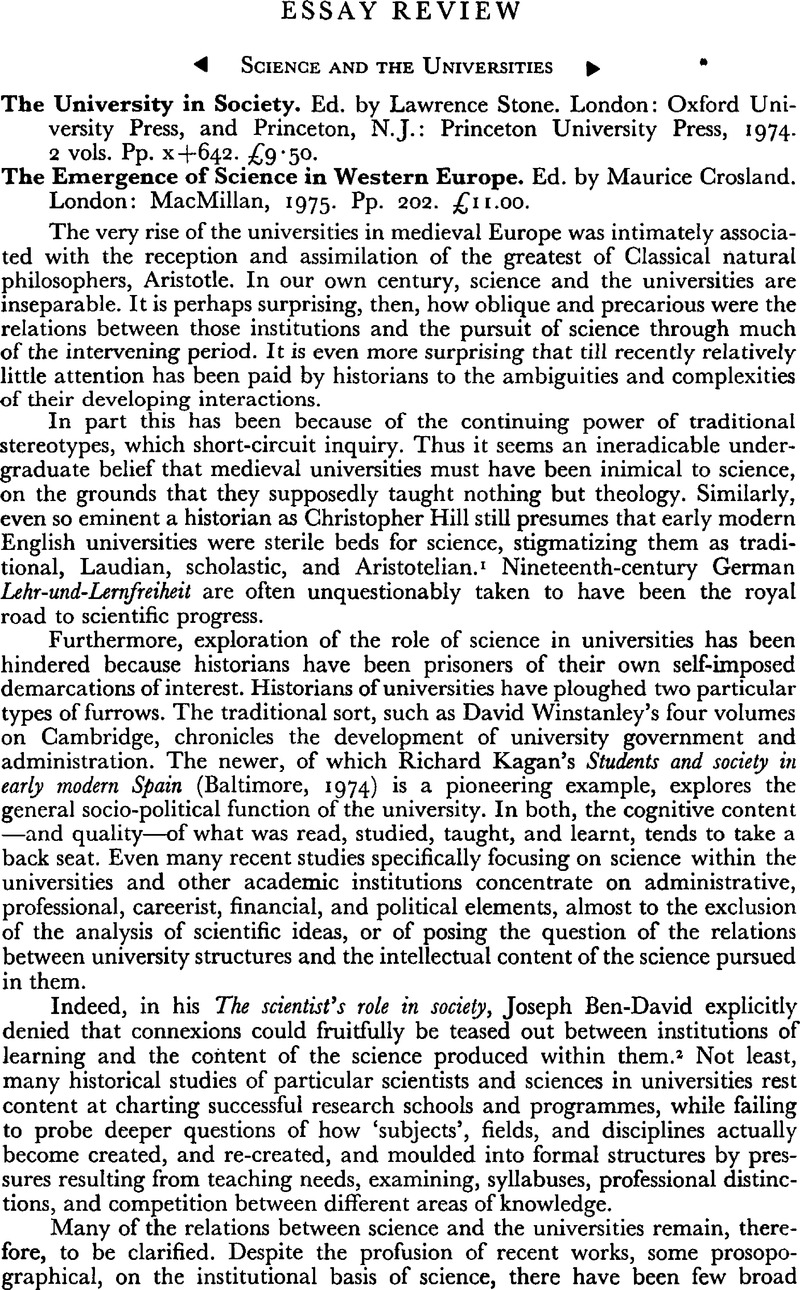No CrossRef data available.
Article contents
Science and the Universities
Published online by Cambridge University Press: 05 January 2009
Abstract

- Type
- Essay Review
- Information
- Copyright
- Copyright © British Society for the History of Science 1976
References
1 Hill, Christopher, Intellectual origins of the English revolution (Oxford, 1965)Google Scholar, Appendix. For a revision, see Frank, Robert G. Jr., ‘Science, medicine and the universities of early modern England’, History of science, xi (1973), 194–216, 239–69.CrossRefGoogle Scholar
2 Crosland, Maurice's paper, ‘The development of a professional career in science in France’, in The emergence of science in Western Europe (henceforth ES), pp. 139–60Google Scholar, is, perhaps, another example of the isolation of the analysis of scientific institutions from scientific content.
3 Cf. Webster, Charles, The great instauration (London, 1975), pp. 204 ff.Google Scholar
4 Schmitt, C. B., ‘Science in the Italian universities in the sixteenth and early seventeenth centuries’, ES, pp. 57–78Google Scholar; Hackmann, W., ‘The growth of science in the Netherlands in the seventeenth and early eighteenth centuries’, ES, pp. 89–110Google Scholar; Christie, J. R. R., ‘The rise and fall of Scottish science’, ES, pp. 110–26.Google Scholar
5 Engel, A., ‘The emerging concept of the academic profession at Oxford, 1800–1854’, in The university in society (henceforth US), pp. 305–51Google Scholar; McLachlan, J., ‘The Choice of Hercules: American student societies in die early nineteenth century’, US, pp. 449–94*Google Scholar; Jarausch, K. H., ‘The sources of German student unrest, 1815–1848’, US, pp. 533–70.Google Scholar
6 See the statistics for Oxford offered by Stone, Lawrence in his ‘The size and composition of the Oxford student body, 1580–1909’, US, pp. 3–110.Google Scholar
7 Rothblatt, S., ‘The student sub-culture and the examination system in early nineteenth century Oxbridge’, US, pp. 247–304Google Scholar; Church, Robert, ‘Economists as experts; the rise of an academic profession in America, 1870–1917’, US, pp. 571–610Google Scholar; Turner, R. Steven, ‘University reformers and professional scholarship in Germany, 1760–1806’, US, pp. 495–532.Google Scholar
8 Cf. Rothblatt, Sheldon, The revolution of the dons (London, 1968).Google Scholar
9 Cf. Farrar, Wilfred, ‘Science and the German university system, 1790–1850’, ES, pp. 179–92.Google Scholar
10 For Crosland, see above, note 2. For Hahn, see ‘Scientific careers in eighteenth-century France’, ES, pp. 127–38.Google Scholar
11 Hahn, Roger, The anatomy of a scientific institution. The Paris Academy of Sciences, 1666–1803 (Berkeley, Calif., 1972).Google Scholar
12 See Hahn, , op. cit. (10), note 36, p. 138Google Scholar, and Fox, Robert, ‘Scientific enterprise and the patronage of research in France, 1800–70’, Minerva, xi (1973), 442–73.CrossRefGoogle Scholar
13 Cardwell, D. S. L., The organisation of science in England (2nd edn., London, 1972)Google Scholar; Sanderson, M., The universities and British industry, 1850–1370 (London, 1972).Google Scholar




